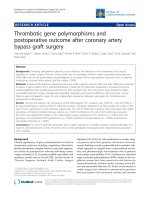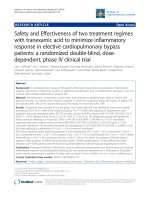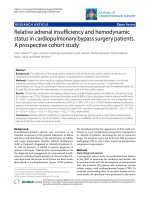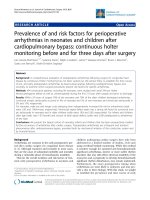Báo cáo y học: "Cardiopulmonary Bypass" ppt
Bạn đang xem bản rút gọn của tài liệu. Xem và tải ngay bản đầy đủ của tài liệu tại đây (115.57 KB, 1 trang )
is book aims at providing an ‘easily readable source of
material for the everyday practice of clinical perfusion’.
e information included should interest both new-
comers to perfusion and also more experienced per-
fusion ists, anesthesiologists and surgeons.
is 207-pages work includes 15 chapters, is well
illustrated and contains a lot of tables and interesting
diagrams. e fi rst chapters present the equipment and
the preparation of the cardiopulmonary bypass (CPB)
circuit, the conduct of the bypass and the process of
weaning from mechanical to physiological circulation.
Two chapters describe the management of the hemostatic
and metabolic consequences of the CPB circuit. One
chapter is dedicated to myocardial protection. e eff ects
of extracorporeal circulation on the body are described,
with particular attention to the brain and the kidney, two
organs at high risk of complication after CPB. Mechanical
circulatory support, deep hypothermic circulatory arrest
and extracorporeal membrane oxygenation are described
in specifi c chapters. e last chapter describes CPB in
noncardiac procedures, such as thoracic aortic surgery,
pulmonary embolism, hepatic and pulmonary trans plan-
tation, major oncologic surgery, and trauma. e editors
and authors are UK and US anesthetists, perfusionists
and surgeons with recognized expertise in the fi eld of
CPB.
is book covers most of the topics related to the
management of CPB – in adults. Unfortunately, there is
no chapter dealing specifi cally with pediatric CPB.
e information provided in this book is relatively
basic, and is less complete than in many textbooks on the
subject. Several chapters refer to relatively old concepts
of perfusion that have been challenged since (that is, the
use of crystalloids as the priming fl uid, management of
the on-bypass hematocrit on bypass, overview of the
coagulation cascade, and so forth). Little information is
provided about new perfusion approaches such as the
Heart Port
®
technique, the mini-bypass technique, the
diff erent coating options of the bypass circuitry, the
diff erent mechanical circulatory support devices, and so
forth. In this fi eld, the more recent strategies are not
described.
Each chapter ends with suggested further reading that
most often includes other reference books or relatively
old articles, which do not really represent the actual
trends in clinical perfusion.
In conclusion, while this book should interest both
newcomers and experienced perfusionists, it does not
fully meet its objectives – sometimes being incomplete
and sometimes being too basic.
Abbreviations
CPB, cardiopulmonary bypass.
Competing interests
The authors declare that they have no competing interests.
Author details
1
Department of Cardiac Surgery, Hôpital Universitaire des Enfants Reine
Fabiola, Avenue JJ Crocq 15, B-1020 Brussels, Belgium.
2
Department of
Anesthesia, CHU-Brugmann Hôpital Universitaire des Enfants Reine Fabiola, 4
Place Van Gehuchten, B-1020 Brussels, Belgium.
Published: 18 March 2010
© 2010 BioMed Central Ltd
Cardiopulmonary Bypass
Luc Rondelez
1
and Philippe Van der Linden
2
*
Edited by Ghosh S, Falter F, Cook DJ. Cardiopulmonary Bypass. Cambridge, UK: Cambridge University Press;
2009. 207 pp. ISBN-13: 978-0521721998
BOOK REPORT
*Correspondence:
2
Department of Anesthesia, CHU-Brugmann Hôpital Universitaire des Enfants
Reine Fabiola, 4 Place Van Gehuchten, B-1020 Brussels, Belgium
Full list of author information is available at the end of the article
doi:10.1186/cc8900
Cite this article as: Rondelez L, Van der Linden P: Cardiopulmonary Bypass.
Critical Care 2010, 14:306.
Rondelez and Van der Linden Critical Care 2010, 14:306
/>© 2010 BioMed Central Ltd









